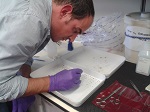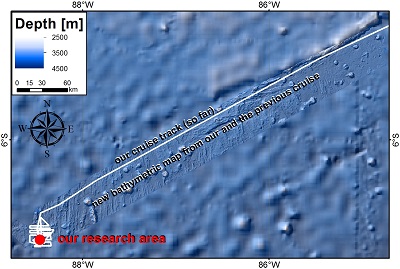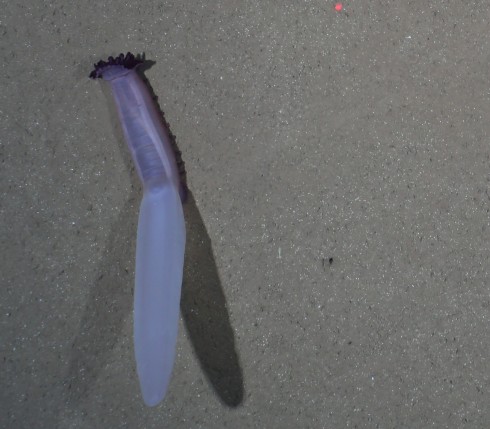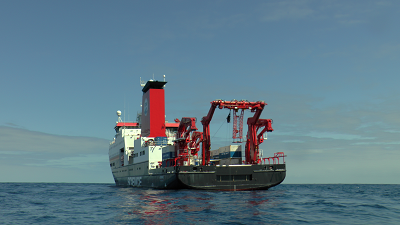Questions from a school class
A number of the scientists and crew taking part in SO242-2 are based in Bremen, Germany. We have received a number of interesting questions from year 6 students attending the International School Bremen, sent to us by their teacher, Martyn Robinson-Slater. We in this blog will try and answer some of them!
How long will you be on the RV Sonne and how long will the project take to complete?
Alina Garuba and Victor Enge/ Answer from Kristin Hamann
This research expedition lasts from August 28th until October 1st. The transition from the harbor in Guayaquil, Ecuador, to the research area lasted two days. The rest of the time is needed to conduct the experiments that were planned ahead. This is a quite long expedition, but we need the time to conduct all the experiments and to collect samples. Some of these samples can already be analysed on board, but a lot of work has to be done at home as well.
The expedition is undertaken within the project “JPI Oceans – Ecological Aspects of Deep-Sea Mining”. It started this Year in January and lasts until December 2017. At the end of the project we will have gathered more knowledge about the deep-sea ecosystem and the impact of mining and we aim to contribute to international legislation with our research. The knowledge about the deep-sea ecosystem is needed to assess the impact of disturbances, in this case deep-sea mining.
Will the RV Sonne be doing survey work anywhere else in the world?
Inès Berkhouwer/ Answer from the ship’s master Oliver Meyer
Yes, the vessel can do survey work anywhere else, excepted are the polar regions of the Arctic and Antarctic. Usually the research vessels are intended to work in determined regions. The main region of the RV Sonne is the Pacific and Indian Ocean in the tropical,
subtropical and temperate climate zones.
Within the years 2015 and 2016 RV Sonne will call the ports of Guayaquil (Ecuador), Antofagasta (Chile), Wellington (New Zealand), Auckland (New Zealand), Dutch Harbour (USA), Petropawlowsk Kamtschatsksi (Russia, but anchorage only), Hakodate (Japan). Yokohama (Japan) and Noumea (New Caledonia).
What is the size of the RV Sonne?
Nitharsan Janakan/ Answer from the ship’s master Oliver Meyer.
The length over all is 118,42 m. The width is 20,6 m at the hull. The starboard bridge wing is extending the width to 23,82 m. Maximum draft is 6,60 m.
The gross tonnage is 8554.
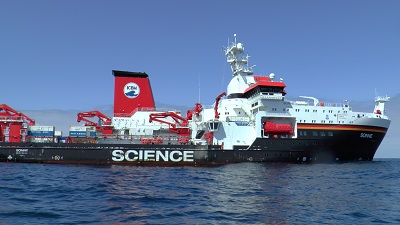
RV SONNE, SO242-2. The weather is beatiful and the sea calm. The research is undertaken in 4000m depth.
How many people are on the RV Sonne and what are their jobs?
Inès Berkhouwer / Answer from Oliver Meyer
We are 40 scientists and 31 crew members.
The 31 members of the crew have following jobs:
3 nautical officers for the watches on the bridge, Responsible for different ship´s equipment like safety equipment, navigation equipment; Doing administration for their duties and departments;
1 ship´s doctor be responsible for the ship´s hospital and medical equipment; to provide medical help, if necessary administration;
3 engineers for the engines and its systems incl. maintenance and repairs, administration for their duties;
2 electricians for the engines and electrical systems incl. maintenance and repairs;
2 electronic engineers for the hardware, electronic equipment and to provide electronic help to the scientists;
1 system operator for the software and networks;
1 fitter for maintenance and repairs all over the vessel on deck and engine in regard of sanitary systems, hydraulic systems, cranes etc.:
3 mechanics for the engines for the watches, maintenance and repairs;
1 bosun as a leader for the following deck crew incl. maintenance and repairs, administration for his department;
7 mechanics / A.B. on deck to handle the cranes, winches, maintenance and repairs on deck and to assist for the scientific work;
2 cooks to plan and prepare the meals, administration for their duties;
4 stewards to assist the cooks, dish washing, clean the cabins and public rooms like the messroom
and at last 1 master to lead the vessel and its crew, to arrange and agree the scientific works together with the chief scientist in regard of safety for the persons, weather etc., administration like reports, preparing the p ort calls, crew affairs, ship´s affairs, public and official communicationto ship´s company, port agents and other persons etc.
What are the living conditions like on board the RV Sonne?
Alec Antoniou/ Answer from Kristin Hamann
Everybody is always quite busy – Even on Sunday and even at night. The gears and the scientists are working 24/7 to use every minute on board to collect samples and do lab work. This is necessary as day on board costs XXXX Euro. We get three warm meals per day and our cabins are cleaned once a week, we only have to take care of our laundry to focus entirely on our work. The support of the crew is very good!
We also have free time; for example, when we are waiting for the ROV to dive up and bring new samples. In this time we can use the SONNE’s gym, the sauna, the kicker, the library or we can enjoy the sunshine. The internet connection is poor, but what is really great is that mobile messages are working here. And the SONNE has a movie collection and we sometimes meet to watch a movie together.
What are the scientific specialisms of the scientists on board the RV Sonne?
Vishal Ravindra Krishna / Answer from Kristin Hamann
The expedition is dedicated to the marine life of the deep sea. Most of the scientists are biologists who are specialized in different fields of biology, like ecology, biochemistry, microbiology. For a comprehensive analysis there are also geologists and geochemists on board. Technicians take care of the tools and the underwater roboter ROV KIEL 6000 and the AWI Tramper.
Why is the survey working in this area?
Hannah Moxey/ Answer from Kristin Hamann
26 years ago scientists conducted the Disturbance and Recolonization experiment in this area. Now we are revisiting this experiment to assess the recovery of the area. You can read more about the history in this area in the blog of Gerd Schriever. He was present when the experiment was conducted and had now the chance to visit this place again.
What is the location where the survey work is taking place?
Jonas Helbich Tejada/ Answer from Sebastian Roessler
The location is in the Peru Basin of the South Pacific, approximately 1100km west from the coast of Ecuador and 850km south of the Galapagos Islands. In the 80s German scientists identified this area suitable for the disturbance experiment.
Today, we are able to find the exact position of the experiment which took place 26 years ago by using a combination of GPS-satellites, underwater positioning and bathymetric data we acquired during this cruise and the cruise before (see map).
Since the satellite navigation only works above water, another method is used to find exact positions of locations under water: Maybe you know from swimming, that you hear much more under water than you can hear above the water surface. That’s because sound can travel easier and with a greater velocity in water than in air. This allows us to scan the seafloor (for bathymetric maps) and to measure the distance to so called Pingers (that’s what they really do, they make a “ping”-noise) which are attached to underwater devices and therefor to determine their accurate position.
How many different types of creature have you found in the trench?
Juline Büßelmann / Answer from Autun Purser/Yann Marcon (Megafauna studies)
This is a good and difficult question! Here on the ship we are taking still photos and video recordings of areas of the seafloor (ploughed tracks, non-ploughed seafloor etc) to see which larger animals are living in each. Other colleagues are collecting mud samples from these areas to see which other animals are living within the muds – and there can be many, both big and small. We won’t really know how many are living in the muds until they have had a chance to go through all the samples with a microscope.
What we can say is that there are less types of big animals in the ploughed areas than in the non-ploughed areas. In the ploughed areas most of the manganese nodules have been removed from the surface, so animals which need a hard base to live on can no longer find a useful place to inhabit. So, there are very few corals, sponges and barnacles in the plough-tracks than outside them, whereas other mobile animals, like the fish in the picture, can enter and leave the tracks as they like.
We have not yet had time to count the exact numbers of types of animal living in the tracks yet, but it is almost certainly less than outside the tracks!
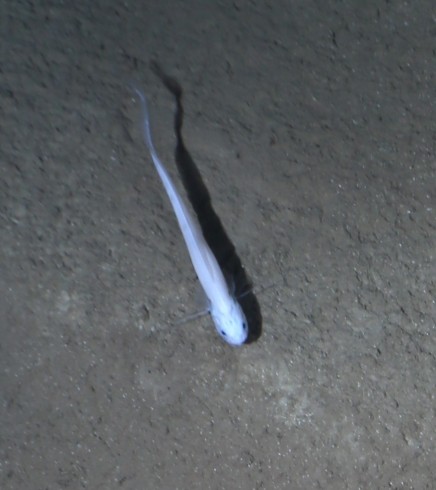
Photo of one of the various deep sea fish we have spotted in the area, here swimming in a plough track. (Photo: Ofos; AWI)
Have you found any new species of creature during this voyage, if so what are they called?
Question from Camille Cazabeau and Maema Chowdhary / Answer from Autun Purser/Yann Marcon (Megafauna studies)
We are mostly taking photos and videos of the seafloor, and we may be seeing animals which are new species to science. It is difficult to be really sure unless you can collect some samples directly and send these to experts working at museums and research institutes around the world. These areas of the deep sea seafloor are difficult to reach, so it is often possible years can go by between an animal first being seen and another cruise being in the position to collect a specimen. We have been asked by colleagues onshore to look out for certain animals to collect, which are not well known to science and need better study. One such animal is the big spidery creature in the photo here, shown eating a dead ‘salp’ , researchers on land want to find out if it is just a HUGE 30cm version of some previously observed smaller animals, or a new species altogether. We are trying to keep an eye out for this during the Remote Operated Vehicle (ROV) dives, so it can be collected. Maybe it is a new species, maybe not! As to naming it, this can be a long process and you cannot just name it anything you like, it has to follow the naming rules, so you cannot just name it after yourself, unfortunately!
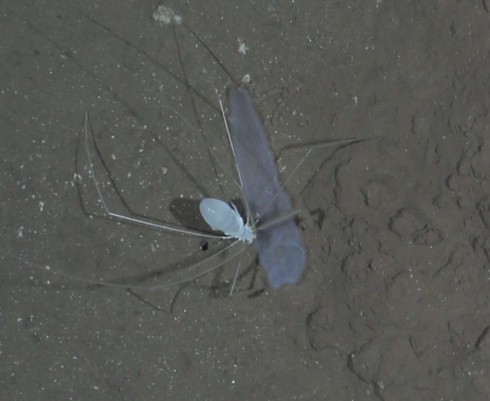
(Photo of large isopod (crustacean, distantly related to the sowbug, which lives in under stones – hear eating a dead ‘salp’, which has fallen from the surface waters to the seafloor after death… legs give the animal a size of 30cm!) (Photo: Ofos; AWI)
What is the scientific name for the fluorescent blue octopus on your blog?
Camille Cazabeau / Answer from Autun Purser/Yann Marcon (Megafauna studies)
…We don’t know for sure! We know it is not a ‘cirrate’ octopus, they have swimming appendages on top like the famous ‘dumbo’ octopus, so it is an ‘incirrate’ octopus. We have sent some photos to experts on land, as we have observed several times the octopus with its eggs (see photo) – these eggs are on dead stalks of other animals on the seafloor, and it is likely the female octopus spends years looking after the eggs before they hatch… Hopefully when we are on shore and can look through the guides to animals and previous scientific papers we can identify exactly which species we are seeing here. Actually, we have seen at least two different types of octopus on the seafloor, but the fluorescent blue type is the most common here. There is another photo here showing the ‘cirrate’ , or ‘dumbo’ type octopi we see in the area. You can see the swimming appendages, the ‘dumbo ears’ quite clearly.

Photos of one of the octopus species we are finding in the area. This is the blue octopus curled around its eggs, brooding them. (Photo:
Ofos; AWI)
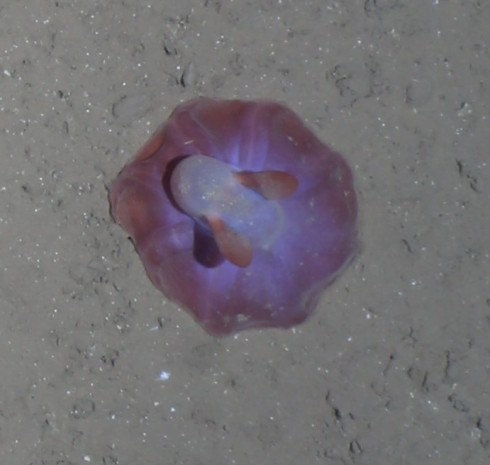
This photo shows the ‘dumbo’ types cirrate octopus we have spotted several times. (Photo: Ofos; AWI)
What is the total number of different creatures you have found on this voyage?
Emma Schmitz / Answer from Autun Purser/Yann Marcon (Megafauna studies)
Well, as mentioned in one of the other posts – the small and microscopic animals have not yet been counted in the samples of mud collected… The microbiologists tell us that we can expect thousands of new species from the area when it comes to the small, unicellular life.
But for the larger animals, those you can see with a camera, we have seen several hundred species of sea cucumber, anemone, starfish, fish, coral, sea spider, crab, shrimp, jellyfish etc already, and we will spend longer, with colleagues, going through all the photos and videos back on shore. What is clear is that much of the deep sea, especially areas with bits of hard ground, (in this case the manganese nodules), are actually full of life, and many different kinds of life, and not the empty muddy plains people used to believe in the early 19th century.
What is the largest creature you have discovered during the research?
Leandra Fritzsche / Answer from Autun Purser/Yann Marcon (Megafauna studies)
I could cheat here and say ‘whale’! When you are far offshore in many areas of the world’s oceans whales and dolphins are often spotted near your research ship. On this cruise, during the first two weeks we saw many whales and dolphins around the ship. We have seen less the last week, perhaps they have got bored with us and gone on somewhere else? Just today a big finback whale came be when were eating lunch.
Anyway, on and near the seafloor fish are probably the biggest animals – we have seen several almost 1m long deep-sea fish swimming past the cameras. Some of the sea cucumbers are also very big, almost 0.5m in size (the one in this picture is about 30cm, but with a large ‘sail’ extended). We have also seem some pretty big isopods (hard shelled animals a bit like crabs), with legs 40cm in diameter. If you do not like spiders you might not like the sea spiders found in the area, these can be 30cm in size and can even swim. Note that they are not real spiders, but some strange phylum exclusively inhabiting the oceans.
How is the launcher operated and what is the maximum depth the launcher (camera) can be used?
Bright Idemudia and Bright Idemudia / Answer from Johannes Lemburg
The Launcher basically is a heavy weight on a fiber cable, with light and cameras on it. Its operated by moving the whole ship quite precisely, dragging the cable with the instrument along. The winch operator has the most important job, because he keeps Launcher at a steady “height” of 1,5m above the sea floor. The scientists just take pictures and request changes of the direction if needed. The Launcher has got two cameras, that are both rated for 6000m depth. One video camera for continuous live feed and one high resolution still camera for photo-mosaiking.
Why are you doing this research?
Liam Lambert / Answer from Antje Boetius
Many people – including politicians and scientists – question our current and future use of the oceans. Especially the potential effects of deep-sea mining remain unknown, and so we were asked to study this area in the deep sea in the Peru Basin, where scientists started a small-scale experiment 26 years ago simulating deep-sea mining on a square kilometer area. With our research here we can find out if the seafloor and its fauna (creatures that live here) has recovered or not. Then we have some scientific data, which we and others can use, to discuss the question if one could take resources from the deep sea without destroying habitats and losing species, and what measures should be taken to manage the deep sea resources well.
The deep sea is so different from land in this respect, as any destruction cannot be repaired – humans cannot “heal” deep sea-floor as they can with grassland or forests.
Have you reached any conclusions from your initial observations during the survey?
Omar Hijazi/ Answer from Antje Boetius
The first important conclusion was that the plough tracks from the original simulation of manganese nodule mining are still there. Imaging you write your name into sand on a beach, then come back 26 years later and look for it and still find it? Even though the deep sea has very little currents and waves, we were astonished to see these old traces. Now we are studying if the plough tracks have changed the distribution of deep-sea animals and also microbes, as well as their activity. Quite expected, some of the animals that prefer to sit on nodules are now rare in the area where nodules were removed. But what is completely astonishing is that also the microbes show a decreased activity in those tracks where the nodules and surface sediments were removed. For this we need more data and measurements at home to come to final conclusions.
Are there any other research projects taking place on the RV Sonne other than in relation to sea creatures?
Tracey Nwaiwu/ Answer from Antje Boetius
Yes, the Research Vessel SONNE can support lots of different scientific projects beyond biological research. Examples are studies of the gas exchange between atmosphere and ocean, the question of how ocean currents are changing, the study of seafloor structures like the distribution and shape of subsea mountains, volcanoes, canyons and trenches. It is used to assess the evolution of ocean basins and the deep subsurface structure of the seafloor by seismics. Or it can help deploying marine technology, such as tsunami alert buoys, moorings with sensors, gliders and robots. We call this a multipurpose – multidisciplinary research vessel. One of my favorite new functions of the ship is that it can almost stand still above a fixed position, one night we were navigating it so that it would follow a 2 m wide track for kilometers, some 4 km under us. One can tell the officers “please 5 m ahead – 10 m at 90 degrees” to steer our cameras over small objects on the seafloor. This is really cool!
What is the overall cost of this project and who is funding the project?
Marwin Sakhri/ Answer from Kristin Hamann
The project consists of 25 partners from different European countries. The project is funded by each national funding agency. As we have still 2,5 years ahead of the project we cannot yet say what the overall cost is, but the budget totals in approximately 9,5 mil. Euro.
